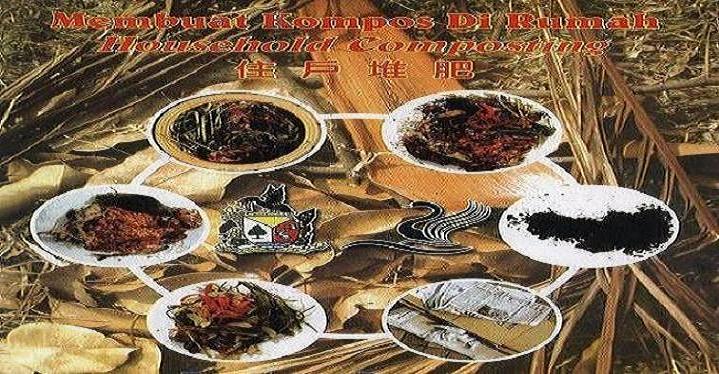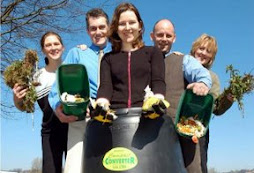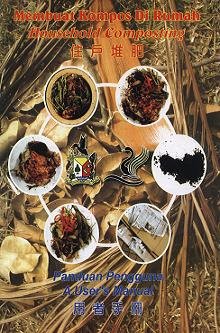
1. Plastic Bag Composting
Materials
- Empty plastic bags/sacks
- Soil
- Browns (dried leaves, twigs, paper, etc)
- Hooks
- Kitchen waste
Method
1. Punch holes in plastic bags to provide adequate aeration.
2. Put a layer of soil at the bottom of the bag.
3. Alternate your kitchen waste with browns until the plastic bag/sack is full and move on to the next one.
4. Plastic bags may be tied up and hung with hooks on fences or stacked up neatly.
5. Remember to keep the contents moist at all times.
6. Compost can be ready for use in 4- 5 weeks' time.

2. Flower Pot Composting
Materials
- Empty flower pots
- Kitchen waaste
- Soil - 1 pot
- Water
- Shovel
Method
1. Lay a layer of gravel or stones at the bottom of the pot for aeration.
2. Put a layer of soil (about 2 inches) on top of this.
3. Put in the biodegradable waste, and dry leaves (if available).
4. Cover loosely with a layer of soil.
5. All holes and crevices should be covered with soil to avoid vermin and animals such as flies, cockroaches, cats and dogs from digging up the food. Covering with soil also prevents odour.
6. The amount of soil should be proportional to the volume of waste (about 20% soil).
7. Do this everyday until the pot is full. Use the next flower pot when the first one is full.
8. Your compost should be ready in 4 - 5 weeks' time, and can be used as fertilizer for plants, trees or lawn.
9. You can use the pot again to bury your waste or use a new pot.
10.Pots may be stacked on top of each other, but the contents must be kept moist at all times.

3. Tower Tyre Composting
Materials
- Old tyres
- Kitchen waste
- Soil
- Water
- Shovel
Method
1. Make two or three piles of old car tyres (4 - 5 tyres stacked up for a pile) directly on the ground, and use them as a container for composting.
2. To aerate, just insert anything (a stone, piece of wood, etc) in between the tyres.
3. If placed directly on cemented ground, line the bottom with soil first.
4. Alternatively, old drums, water containers without bottoms, or even rice sacks (supported by 3 pegs) with bottom ripped open can be used.
5. Use the method as in flower pot composting above.

4. Compost Pits
Materials
- Small branches or twigs
- Hollow tube with holes (plastic or bamboo)
- Kitchen waste or food scraps
- Soil
- Water
- Shovel
Method
1. Dig two pits 2ft x 2 ft x 2ft. The pits should be situated in a place exposed to sun and air.
2. Put small twigs at the bottom and place a hollow tube for air circulation.
3. Place the kitchen waste (vegetables, fruit trimmings and peelings, leftover food, etc) into the pit and cover with sufficient soil to ensure that no odour emanates from the pit.
4. If a single fly is seen hovering around the pit, add more soil to cover the kitchen waste.
5. Do not compact the soil but allow it to loosely cover the contents of the pit and ensure tha the soil adequately covers the kitchen waste.
6. Keep compost pit moist and moderately wet.
7. Repeat the process until the pit is full.
8. During heavy rain, cover the pit with a piece of wood or plastic to prevent too much water from entering the pit.
9. Use the second pit while waiting for the biodegradable waste in the first pit to fully decompose.
10.Decomposition usually takes 3 - 4 weeks for small pits, and 3 - 4 months for big pits.
11.To test if the compost is ready, scoop a little portion from the pit and if no foul odour emanates from it, then decomposition is complete.

5. Wire Hoop Composting
Materials
- 10ft x 3ft piece of heavy-duty wire mesh fencing
- 4 pieces of wire or other easy-to-twist wire
- Graden waste
- water
- Shovel
Method
1. This system is suitable for yard or garden trimmings only.
2. Chop them into smaller pieces if you wish to ensure faster decomposition.
3. Form the wire mesh into cylinderical form and tie up the ends with 4 pieces if wire.
4. For best results, install a location that is protected from the wind, and where there is enough space to turn the compost easily ( about 3ft x 6ft).
5. Add in garden material (browns and greens) in alternate layers until heap is full.
6. Compost can be turned by unfastening th hoop, setting it up in an adjacent spot, then forking the compost into the hoop in its new location.
7. Maintain compost by keeping it as moist as a wrung-out sponge.
8. Harvest rich brown compost from the bottom and the center of the pile after 12 - 18 months.

6. Heap Composting
Materials
- Garden waste
- Water
- Shovel
Method
1. Choose a designated location in your garden.
2. Pile garden waste in a heap and water once every week if weather is dry.
3. Turn the compost pile over after 4 - 5 months.
4. The compost can be harvested after 11 - 12 months.












No comments:
Post a Comment